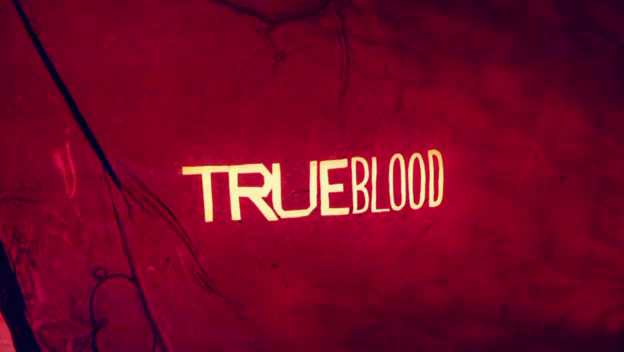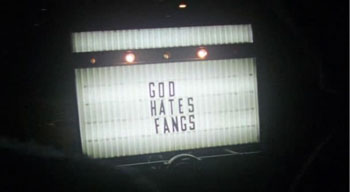 What might the opening title sequence from HBO’s popular vampire series True Blood tell us about “vernacular religion” in our post-9/11 context? And what does this say back to institutional religion?
What might the opening title sequence from HBO’s popular vampire series True Blood tell us about “vernacular religion” in our post-9/11 context? And what does this say back to institutional religion?
While researching Burning Man Festival for my MA thesis a few years ago the book God in the Details: American Religion in Popular Culture, edited by Eric Michael Mazur and Kate McCarthy (London and New York: Routledge), was helpful with one of its chapters. The second edition from 2010 includes new material, including the intriguing essay “I Wanna Do Bad Things With You: Fantasia on Themes of American Religion from the Title Sequence of HBO’s True Blood,” by Leonard Norman Primiano.
Dr. Leonard Norman Primiano is Professor and Chair of Religious Studies at Cabrini College. He came to Cabrini’s Religious Studies department in 1993 with a foundation in religious studies and folklore and folklife studies, and a desire to teach courses on the history of Christianity, vernacular religion, religious folklife, contemporary moral problems and contemporary American religion. Throughout his years at the College, he has dedicated himself to teaching students about the relationship of these exciting fields.
Dr. Primiano discusses a few of the aspects of his chapter on True Blood in this interview.
TheoFantastique: Leonard, thank you for helping me get a copy of your chapter from the new edition of God in the Details. How did you come to develop an interest in the religious aspects of True Blood, and how does your academic work in folklore help shed light on this?
Leonard Norman Primiano: Believe it or not, John, I did not watch True Blood in its first episodes of broadcast. I only watched several months after the conclusion of the first season when in December 2008 HBO broadcast the season over many hours of one broadcast day. I was looking for a topic to stimulate me for a new contribution to the second edition of the collected essays titled God in the Details. I believe that I began watching the show mid-way through episode two of season one. I was initially fascinated with the way religious material culture had been used on the program, but something also intrigued me with the opening credits montage and the way they represented religion, religious people, religious practices. My scholarly life has centered on the study of what I call “vernacular religion,” or the way people practice their religion in their everyday lives. I am equally fascinated with ways that “popular” or mass media culture represents religion in America and elsewhere. As I watched the second season of the series, I began to develop a better sense of the role that religion played in the series, and what the series was expressing about contemporary religiosity.
TheoFantastique: How does True Blood add to the depiction of the vampire as sympathetic anti-heroes?
Leonard Norman Primiano: The length of the series allows for a richer characterization of the vampires on screen and this development of them as “undead individuals,” if you will, and not merely as spirits with no personalities, definitely assists viewers’ appreciation of them as sympathetic, frightening, intelligent, sexual, heroic, anti-heroic familiars.
TheoFantastique: The thrust of your essay addresses how the series depicts organized religion. I found your discussion of the series’ opening title sequence in this regard of great interest. How did you come to see this as significant, perhaps almost as much as the ongoing depictions of religion in other aspects of the series?
Leonard Norman Primiano: I was immediately struck by what I understood to be the use in the credits of what a folklorist or anthropologist would cite as film footage depicting the “ethnographic” present of the Louisiana country side, its inhabitants, and its religious environs. Wow, I thought, were these credits made in a ethnographic documentary style, and how did the creators obtain permission to film these individuals, and what did they explain was their purpose. I was especially taken by the scene in the church – which was actually filmed in Chicago — with the choir being filled with the Holy Spirit and exhibiting this Christian form of spirit possession. Were the producers of the series actually using real people and real contexts in these scenes? That is when I contacted the credits creators at Digital Kitchen in Seattle, and asked them some basic production questions, especially after reading their own statements on their web site about the opening credits. As it turns out, most of the individuals you see in the credits were “actors” or people they filmmakers know, or who agreed to be filmed in an artificially induced religious context. What I mean is that the church scene was not a documentary of a real Pentecostal service — a naturally induced context — but a church choir and musicians were hired and agreed to create a church service for the cameras, which to them it seems was still quite an authentic spiritual experience, but still not one of their regularly scheduled church services.
TheoFantastique: How do the title sequence, characters, and storylines help us understand the late modern relationship to organized religion, at least in True Blood and its vampires?
Leonard Norman Primiano: The plot lines often reference religion in a variety of forms: organized religion, institutional religion, seemingly “Mainline” Protestantism, sectarian religion in America, “folk” religion (all of the references to Vodou practice), and the vernacular religion of the characters – the myriad ways that the characters interpret and create religion and a relationship to the spiritual in their own lives. That complex constellation of religiosity in so many forms defines religion in America and the world in the twenty-first century; that is the way these characters are living their religion and expressing their spirituality. Still, organized forms of religiosity do receive the harshest judgment in the plotlines which expose them as centers for deception, greed, and hypocrisy.
TheoFantastique: What might those in traditional, organized religions take away from expressions of religion in popular culture like True Blood in terms of connecting more meaningfully or relevantly with what you call “vernacular religion”?
 Leonard Norman Primiano: I think that what those in traditional, organized, institutionalized religion should take away is not that the series represents a triumph of secularization or even sacrilege in American society, but a longing for the sacred, the ritualistic, the experiential, and the sacramental in our society. That the perception and expression of religion in its organized form is changing, or should I say still developing. This idea is more complex today because of the profound religious illiteracy, aka, lack of knowledge of religious traditions, that exists in our society. Even people who describe themselves as religious or spiritual, do not seem to have a firm foundation of knowledge in the religious traditions with which they so identify. Is it surprising then that people may be more creative than ever about the beliefs and practices that make up their religious lives? I suggest in the article that this sense of illiteracy about religious and spiritual traditions, and the negotiations of religious ideas and practices, may also be extended to the way that religious material culture – religious objects and the multiple forms of the materialization of the spiritual — is perceived and employed in the series. I am not saying that there is a right or wrong here in terms of the way people are religious or the way religiosity is depicted. I am not admonishing anyone, but I am noting and analyzing this development in contemporary religion.
Leonard Norman Primiano: I think that what those in traditional, organized, institutionalized religion should take away is not that the series represents a triumph of secularization or even sacrilege in American society, but a longing for the sacred, the ritualistic, the experiential, and the sacramental in our society. That the perception and expression of religion in its organized form is changing, or should I say still developing. This idea is more complex today because of the profound religious illiteracy, aka, lack of knowledge of religious traditions, that exists in our society. Even people who describe themselves as religious or spiritual, do not seem to have a firm foundation of knowledge in the religious traditions with which they so identify. Is it surprising then that people may be more creative than ever about the beliefs and practices that make up their religious lives? I suggest in the article that this sense of illiteracy about religious and spiritual traditions, and the negotiations of religious ideas and practices, may also be extended to the way that religious material culture – religious objects and the multiple forms of the materialization of the spiritual — is perceived and employed in the series. I am not saying that there is a right or wrong here in terms of the way people are religious or the way religiosity is depicted. I am not admonishing anyone, but I am noting and analyzing this development in contemporary religion.
TheoFantastique: Leonard, thank you again for sharing your thoughts and discussing your essay.
Related posts:
“Vampire Evolution: Beyond Americanized and ‘Twilightized’ Depictions”
“HBO’s True Blood: Viral Marketing and Fact-Fiction Reversals”





One Response to “Leonard Primiano: True Blood, Post-9/11 Spirituality, and “Vernacular Religion””